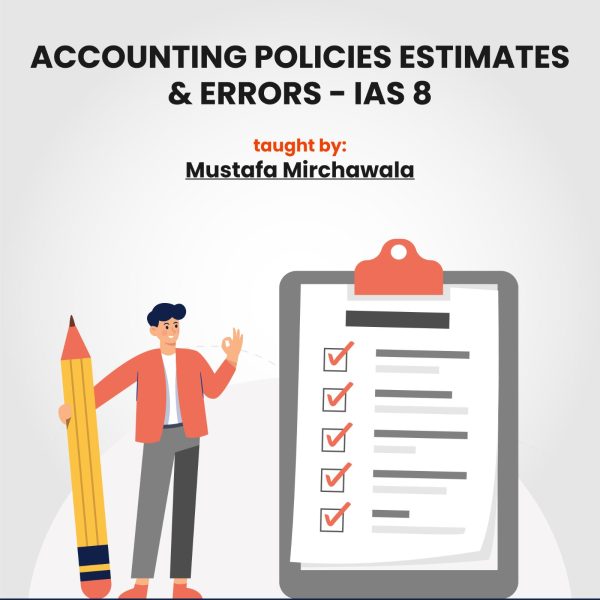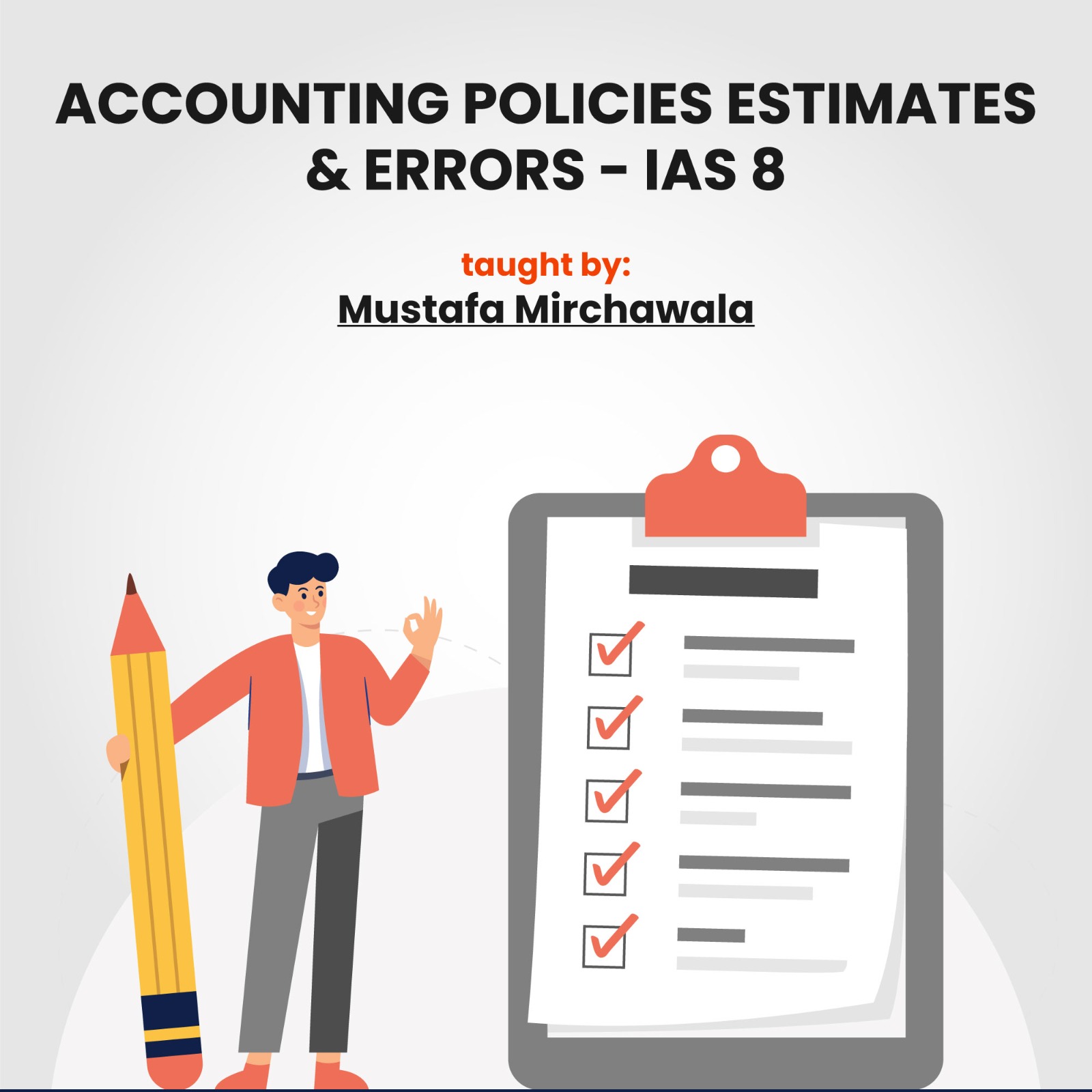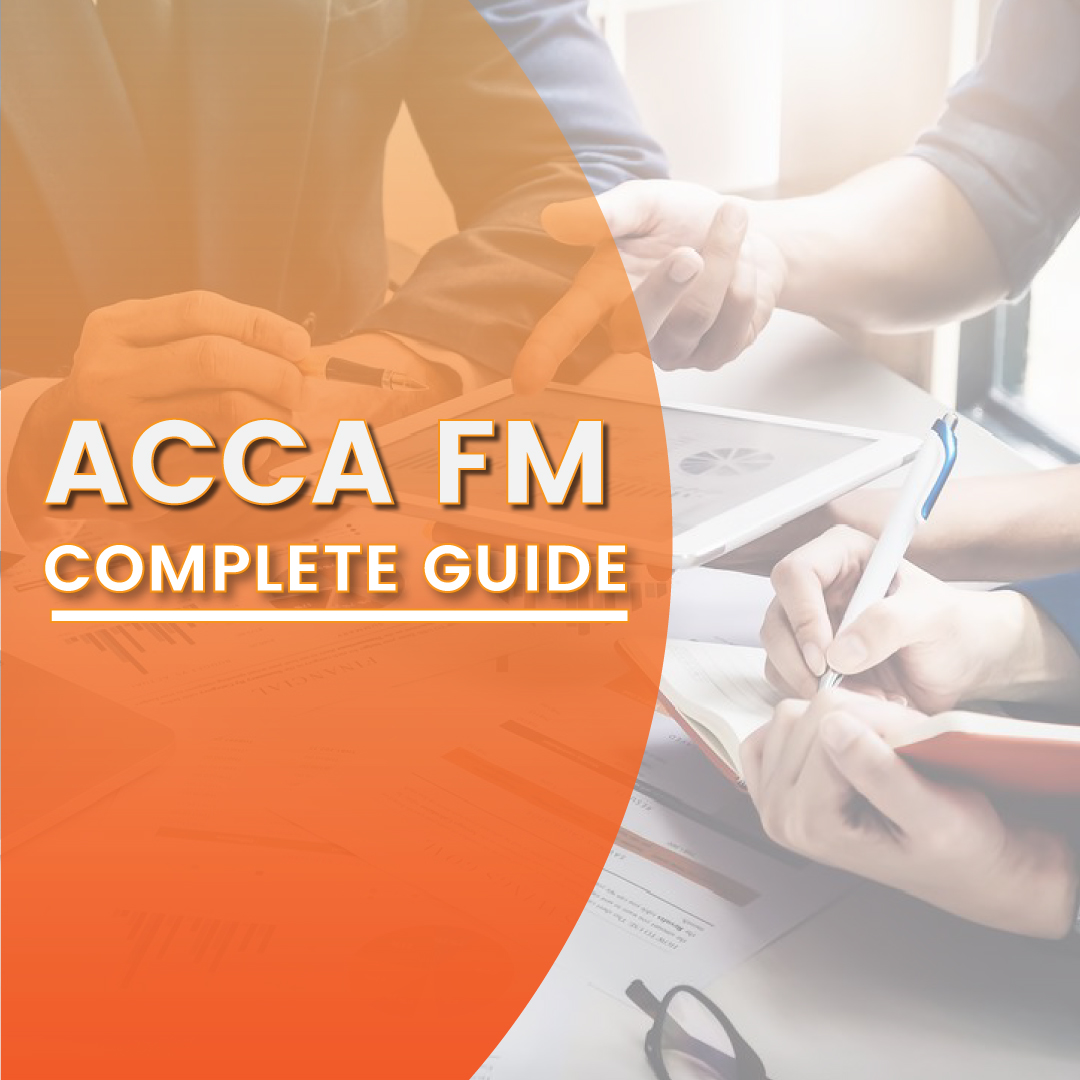Accounting Policies Estimates and Errors: IAS 8
Introduction –Accounting Policies Estimates and Errors: IAS 8
IAS 8 in Financial Reporting FR (F7) governs the following topics:
Selection of accounting policies/changes in accounting policies
Changes in accounting estimates
Correction of prior period errors

First part – Selection of Accounting Policies Changes
A change of policy is allowed only on two conditions:
When the IAS changes, it means that the official accounting standard has changed and that the policy that the company was using earlier is no longer in practice. Therefore, a change in such policy is allowed by the International Accounting Standard Board
Example of a changes in accounting policy:
The inventory valuation method is prohibited under IFRS and ASPE due to potential distortions to a company’s profitability and financial statements. The revision of IAS Inventories in 2003 prohibited LIFO from being used to prepare and present financial statements. After such a change, the companies were allowed to change their accounting policies.
The second condition is any change through which the presentation of financial statements changes and gains relevance. Note: In International Accounting Standard 16, which relates to the cost and revaluation model, The shift from the cost model to the revaluation model is allowed because this increases the relevancy of financial statements. The shift from the revaluation model to the cost model isn’t allowed because this shows a wrong interpretation of financial information. Showing assets at a cost model means we are providing obsolete information to shareholders
Significant Changes in Accounting Policies
This means that whenever we shift the accounting policy, the new policy should also be applied to historical data.
For example, whenever we present the financial statements to shareholders or investors, the previous year’s financial statement is also presented for comparison purposes so that they can compare the company’s past performance with its present state. The threat comes when the company presents the financial statements, and this year’s financial statement is recorded based on the new accounting policy, whereas last year’s financial statement was calculated based on the old accounting policy used by the company. This way, the comparison is not like for like, which is against the International Accounting Standard Board (IASB).
From now on, whenever the teacher says to apply this retrospectively, it means to apply the new policies to old accounts too. But what if the company is 40 years old? Will we apply the new policy to all 40 past financial statements? the answer is no. All those financial statements are restated according to new policies, which are presented to shareholders for comparison.
Changes in accounting policies must be applied retrospectively (Logic for like-with-like comparison)
Retrospective application means “Opening retained earnings” will be adjusted.
Three SOFP (statements of financial positions) and two SOCI (statements of comprehensive income) are restated. Mustafa Mirchawala notes
From LIFO to FIFO – Shift of accounting policy
Before understanding this concept, you need basic knowledge regarding the relationship between closing or opening inventory and profits.
Closing stock has a direct relationship with profit, whereas opening stock has an indirect relationship with profit.
Last year’s closing inventory will increase because in FIFO, closing inventory is based on the most recent prices. Therefore, when closing inventory increases, the profit will increase since profit and closing stock are directly related. indicating that closing retained earnings will also increase. So this year’s opening retained earnings will increase. This impact is on the last year.
But the closing inventory of last year is the opening inventory of this year, meaning when the opening inventory increases, the profit will decrease.
In the current year, when we are shifting our closing inventory from LIFO to FIFO, the closing inventory will increase, hence the profit will increase. So today’s profit will be impacted by this increase in profit and the decrease in profit due to the opening stock increase. You will have to record such a net impact.
Exceptions:
If the retrospective condition is not applicable or not practically possible due to missing records, then we can change the accounting policy prospectively. Prospectively, it means that from now on the new accounting policy will be applied. This is an exceptional condition given by the International Accounting Standard Board (IASB)
The second part of this IAS – Accounting Estimates:
Accounting estimates are judgments used in accounting. E.g. Changes in useful life Changes in scrap value Changes in doubtful debt Changes in provision Changes in accounting estimates will be applied prospectively. Accounting estimates depend upon the availability of information, & this information was not available before.
The third part of IAS 20 – Prior period error:
The error that was made in previous years has now been discovered. This will be adjusted retrospectively. means that the error will be corrected at the time it is incurred. This is because of the matching principle, “expenses are recorded when they are incurred “. Examples of prior-period errors are omissions and misinterpretation of facts
Note: This topic is highly examinable in final accounts
Summary: Changes in accounting policies and corrections of errors are generally retrospectively accounted for, whereas changes in accounting estimates are generally accounted for on a prospective basis.
Example from Previous Year Paper:
For example, at the year-end Dec 2017, there were 54 million out of which 4 million were never received in the company account due to fraud committed by the employee. By doing further research we got to know that 2.5m was received in the current year by the customer but the employee didn’t transfer the amount into companies account so this will be recorded as a current-year expense
The rest of the 1.5 m was received last year by the customer and the employee did the same thing but now this will be adjusted retrospectively. means we will have to go in the last year’s accounts and record it as expense means our profit will decrease and therefore opening retained earnings of the current year will be decreased
Entry will be recorded as
2.5m debit as an expense
1.5m debit retained earning
4m credit Receivable ( which was never received due to fraud )
In case of new accounting transactions in which the company was not involved before, what policy will be applied to it?
If there is any direct and clear solution is given in the IFRS book then it will be dealt with accordingly
If no direct accounting standard is given then the accounting policy applies to the similar transactions will be used to deal with that new transaction
The last option is to deal with the new transaction with the help of a framework
“New accounting policies could be applied retrospectively, without restating any prior year financials”- ACCA global
Distinguishing between accounting policies and accounting estimates
Accounting policies and accounting estimates must be distinguished because changes in accounting rules are normally implemented retroactively, whilst changes in accounting estimates are applied proactively. As a result, the approach used can have an impact on both the reported findings and the patterns between periods.
Because the term accounting estimates was not defined and the preceding definition of a change in accounting estimate was vague, the International Accounting Standards Board (the Board) observed variability in practice in establishing this distinction.
The Board has now issued amendments to IAS 8 Accounting Policies, Changes in Accounting Estimates, and Errors to clarify how companies should distinguish between changes in accounting policies and changes in accounting estimates, with a primary focus on accounting estimate definitions and clarifications.
Conclusion:
In conclusion, understanding International Accounting Standard 8 (IAS 8) and its relevance to Changes in Accounting Policies, Estimates, and Errors might be a little difficult for you before reading this article. As fellow accounting students, we find ourselves in a difficult spot when we are exploring a topic that has been introduced into our standard curriculum for the first time.
The significance of reading and comprehending this blog cannot be overstated. Not only is IAS 8 a fundamental topic of the ACCA (Association of Chartered Certified Accountants) financial reporting exam, but it also plays an important role in our advanced studies, especially the Strategic Business Reporting (SBR) exam. This standard isn’t just an isolated theory, it is linked with other financial reporting exams too.
One of the standout features of this article is the inclusion of practical examples drawn from past papers on financial reporting, making exam preparation more effective and relatable for all the ACCA students. so save this article in your bookmark and remember to read it a day before your next attempt!
if you ever find yourself with complex questions or in need of further clarification regarding IAS 8, don’t hesitate to reach out to Mustafa Mirchawala, an expert in financial reporting. His expertise can provide you with valuable insights and guidance as he is considered to be the best financial reporting teacher out there in the market.
Furthermore, it’s important to acknowledge that our world is changing at a first pace, and this applies to accounting policies as well. As ACCA students, it’s crucial to equip ourselves with the skills and knowledge to adapt to these changes effectively. IAS 8 offers us a solid foundation to understand and navigate these evolving accounting practices.
In closing, I encourage you to explore the FAQs section after reading this blog. It will address common doubts and provide additional insights, further enhancing your understandability of IAS 8. As we continue on our journey to becoming an accountant professionally I hope this article helped you to clear out your concepts.
Frequently Asked Questions (FAQ’s) – Changes in accounting policies Estimates and errors- IAS 8
Q1. What conditions allow for a change in accounting policy under IAS 8?
A change in accounting policy is allowed when either the IAS changes or when the change enhances the relevance of financial statements.
Q2. What is the significance of applying changes in accounting policies retrospectively?
Retrospective application ensures that historical data is restated to enable like-for-like comparisons, maintaining consistency in financial reporting.
Q3. When can changes in accounting policies be applied prospectively instead of retrospectively?
Changes in accounting policies can be applied prospectively if retrospective application is not feasible due to missing records.
Q4. How are changes in accounting estimates handled under IAS 8?Changes in accounting estimates are applied prospectively, considering the availability of new information.
Q5. How does IAS 8 address the correction of prior period errors, and why is this important?
IAS 8 requires the correction of prior period errors to be done retrospectively to align with the matching principle. This ensures accurate financial reporting.
Q6. In the case of new accounting transactions, what determines the accounting policy to be applied?
The accounting policy for new transactions is determined by either a direct solution in the IFRS book, using policies for similar transactions, or referring to the framework if no direct standard is provided.
-Written by Warisha Shehzadi bright student of Mirchawala’s Hub Of Accountancy











